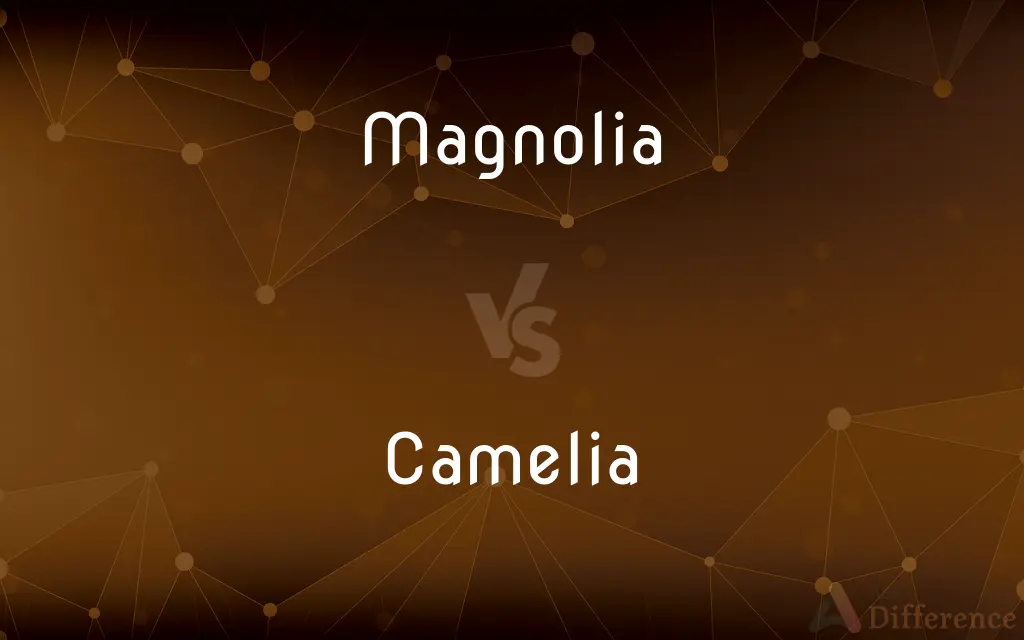Magnolia vs. Camelia — What's the Difference?
Edited by Tayyaba Rehman — By Maham Liaqat — Updated on March 18, 2024
Magnolias are known for their large, aromatic flowers and ancient lineage, while camellias are prized for their glossy leaves and winter blooms.

Difference Between Magnolia and Camelia
Table of Contents
ADVERTISEMENT
Key Differences
Magnolias are an ancient genus of flowering plants, featuring large and often fragrant blossoms that appear before the leaves in early spring. These trees or shrubs are part of the Magnoliaceae family and are known for their broad, showy petals. Camellias, belonging to the Theaceae family, are celebrated for their glossy, evergreen leaves and beautiful flowers that bloom in fall or winter, offering a splash of color in colder months.
The magnolia's flowers are not only large and aromatic but also come in a variety of colors including white, pink, purple, and yellow. They symbolize nobility and dignity in cultural contexts. Camellias, on the other hand, typically display flowers in shades of red, pink, and white and are symbols of love and affection. The camellia sinensis variety is notable for being the source of tea leaves.
Magnolias are native to East Asia and the Americas, showcasing a wide diversity in these regions with both evergreen and deciduous types. Their adaptability allows them to thrive in a variety of climates, from temperate to tropical. Camellias are mostly native to Asia and are particularly revered in Japan and China, where they play significant roles in gardens and tea culture.
When it comes to care, magnolias generally prefer a sunny to partly shaded location with well-draining soil and can be sensitive to transplanting due to their deep root systems. Camellias require acidic, well-drained soil and partial shade, thriving under the canopy of taller trees that mimic their natural woodland habitat.
Despite their distinct characteristics, both magnolias and camellias are highly valued in horticulture for their stunning flowers and the elegance they add to landscapes and gardens. They are often chosen for ornamental planting due to their visual appeal and the unique charm each brings to garden settings.
ADVERTISEMENT
Comparison Chart
Family
Magnoliaceae
Theaceae
Flowering Season
Early spring before leaves appear
Fall or winter, depending on species
Flower Size and Fragrance
Large and often fragrant
Smaller than magnolias, less fragrant
Native Regions
East Asia, the Americas
Mostly Asia
Cultural Significance
Symbolize dignity and nobility
Represent love and affection
Leaf Characteristic
Deciduous or evergreen, large leaves
Evergreen with glossy leaves
Soil Preference
Well-draining, prefers slightly acidic to neutral
Acidic, well-drained
Compare with Definitions
Magnolia
Ancient genus with large, showy flowers.
The magnolia tree in her garden was the first to bloom each spring.
Camelia
Valued for glossy leaves and winter blooms.
The camellias brought color to the garden even in the coldest months.
Magnolia
Flowers appear before the leaves, signaling the arrival of spring.
The bare branches of the magnolia were suddenly adorned with vibrant blossoms.
Camelia
The source of tea leaves, particularly Camellia sinensis.
The leaves of the Camellia sinensis were harvested to make green tea.
Magnolia
Known for their fragrance and wide range of colors.
The air was filled with the sweet scent of pink magnolias.
Camelia
Flowers come in red, pink, and white, symbolizing love.
He gave her a bouquet of red camellias as a sign of his affection.
Magnolia
Prefers sunny to partly shaded spots with well-draining soil.
They planted the magnolia in a sunny corner where the soil was rich and well-drained.
Camelia
Thrives in partial shade with acidic, well-drained soil.
The camellias flourished under the tall oaks, enjoying the acidic soil and dappled sunlight.
Magnolia
Can be either deciduous or evergreen, adapting to various climates.
The evergreen magnolias provided year-round greenery in the garden.
Camelia
Especially revered in Asian cultures for their beauty and tea production.
In Japan, the camellia is celebrated for its elegant flowers and its importance in tea ceremonies.
Magnolia
Magnolia is a large genus of about 210 flowering plant species in the subfamily Magnolioideae of the family Magnoliaceae. It is named after French botanist Pierre Magnol.
Camelia
Camelia (born 20 June 1974, as Dayang Noor Camelia Abang Khalid) is a Malaysian singer and model. She was the first Malaysian to be signed to Universal Music.
Magnolia
Any of numerous evergreen or deciduous trees and shrubs of the genus Magnolia of the Western Hemisphere and Asia, having large, showy, often fragrant white, pink, purple, or yellow flowers, and widely cultivated as ornamentals.
Camelia
Obsolete form of camellia
Magnolia
The flower of any of these plants.
Camelia
Any of several shrubs or small evergreen trees having solitary white or pink or reddish flowers; the camellia.
Magnolia
A tree or shrub in any species of the genus Magnolia, many with large flowers and simple leaves.
Camelia
Any of several shrubs or small evergreen trees having solitary white or pink or reddish flowers
Magnolia
The flower of a magnolia tree.
Magnolia
A native or resident of the American state of Mississippi.
Magnolia
A creamy white colour, like that of some magnolia flowers.
Magnolia
Of a creamy white colour, like that of some magnolia flowers.
Magnolia
A genus of American and Asiatic trees, with aromatic bark and large sweet-scented whitish or reddish flowers.
Magnolia
Dried bark of various magnolias; used in folk medicine
Magnolia
Any shrub or tree of the genus Magnolia; valued for their longevity and exquisite fragrant blooms
Common Curiosities
Can both magnolias and camellias be used for tea?
Only certain varieties of camellias, like Camellia sinensis, are used for tea production. Magnolias are not used for tea.
How do magnolias and camellias adapt to different climates?
Magnolias have both deciduous and evergreen species that adapt to temperate and tropical climates, while camellias, mostly evergreen, prefer milder, humid climates.
What are the soil preferences for magnolias and camellias?
Magnolias prefer well-draining, slightly acidic to neutral soil, while camellias thrive in acidic, well-drained soil.
Are magnolias and camellias easy to care for?
Both require specific conditions to thrive but can be relatively low-maintenance with proper planting and care.
What are the cultural significances of magnolias and camellias?
Magnolias symbolize dignity and nobility, while camellias represent love and affection, with both holding significant cultural value, especially in Asia.
What distinguishes magnolia flowers from camellia flowers?
Magnolia flowers are larger, often fragrant, and bloom early in spring, while camellia flowers are smaller, less fragrant, and bloom in fall or winter.
Are magnolias and camellias resistant to pests and diseases?
While relatively hardy, both can be susceptible to certain pests and diseases, requiring regular monitoring and care to prevent issues.
What wildlife is attracted to magnolias and camellias?
Both can attract a variety of wildlife, including bees, butterflies, and birds, which are drawn to their flowers for nectar and shelter.
How long can magnolias and camellias live?
With proper care, both magnolias and camellias can live for many years, even centuries in some cases.
Can magnolias and camellias be grown in pots?
Both can be grown in pots if they are given enough space for their roots and the right soil conditions, though larger magnolia varieties might not be as suitable for potting.
How do the flowering times of magnolias and camellias benefit gardens?
Magnolias herald the arrival of spring with their early blooms, while camellias add color and life to gardens during the fall and winter months.
Do magnolias and camellias have any medicinal uses?
While not commonly used for medicinal purposes in Western cultures, some species have been used in traditional medicine, especially in Asia.
Share Your Discovery

Previous Comparison
Mazut vs. Diesel
Next Comparison
Essence vs. ElementAuthor Spotlight
Written by
Maham LiaqatEdited by
Tayyaba RehmanTayyaba Rehman is a distinguished writer, currently serving as a primary contributor to askdifference.com. As a researcher in semantics and etymology, Tayyaba's passion for the complexity of languages and their distinctions has found a perfect home on the platform. Tayyaba delves into the intricacies of language, distinguishing between commonly confused words and phrases, thereby providing clarity for readers worldwide.
















































